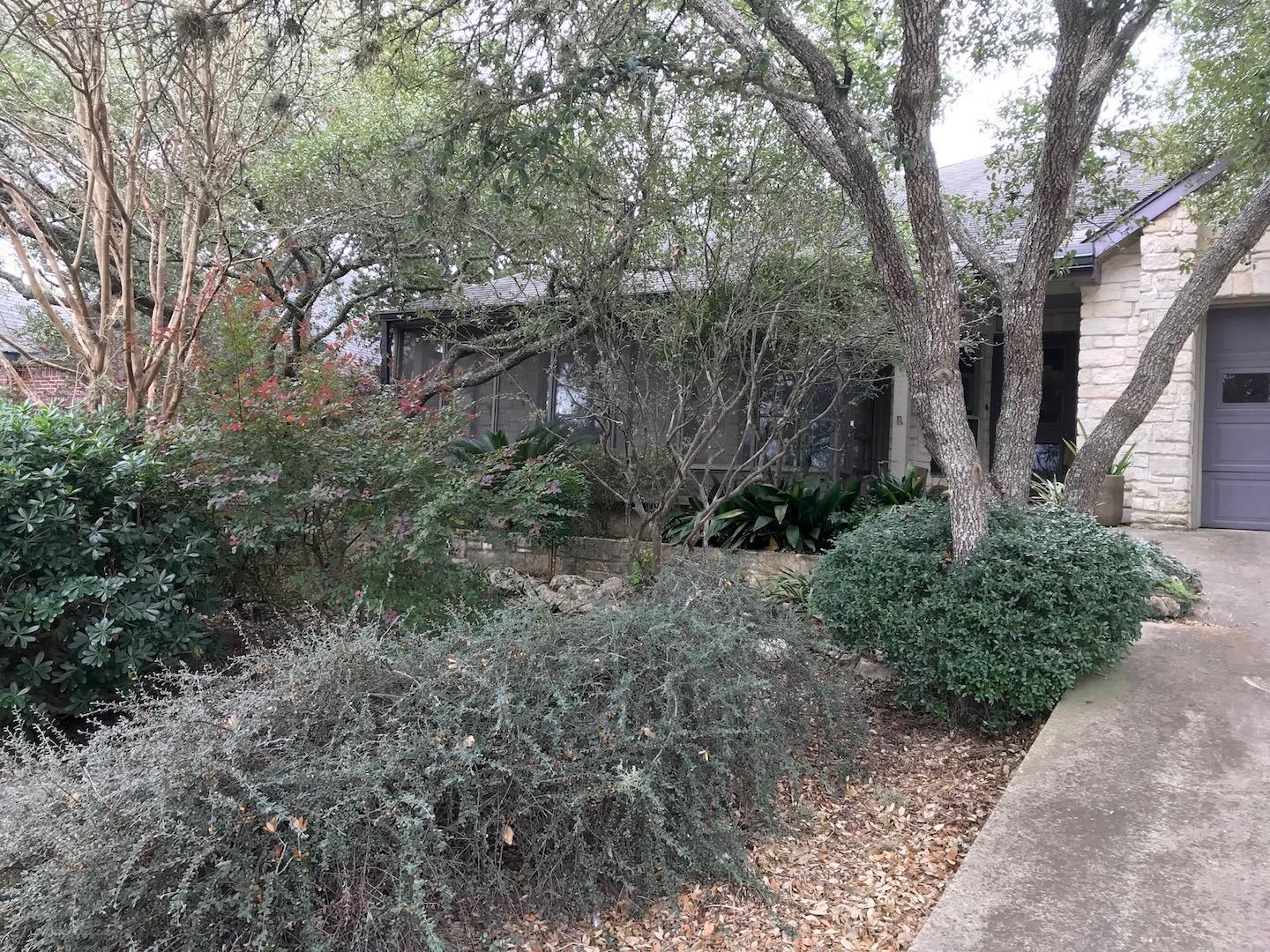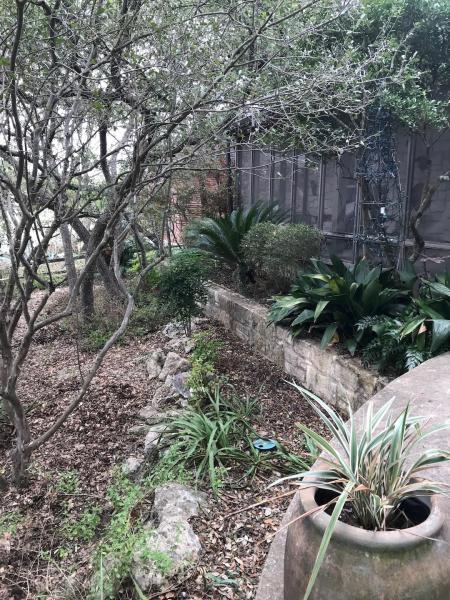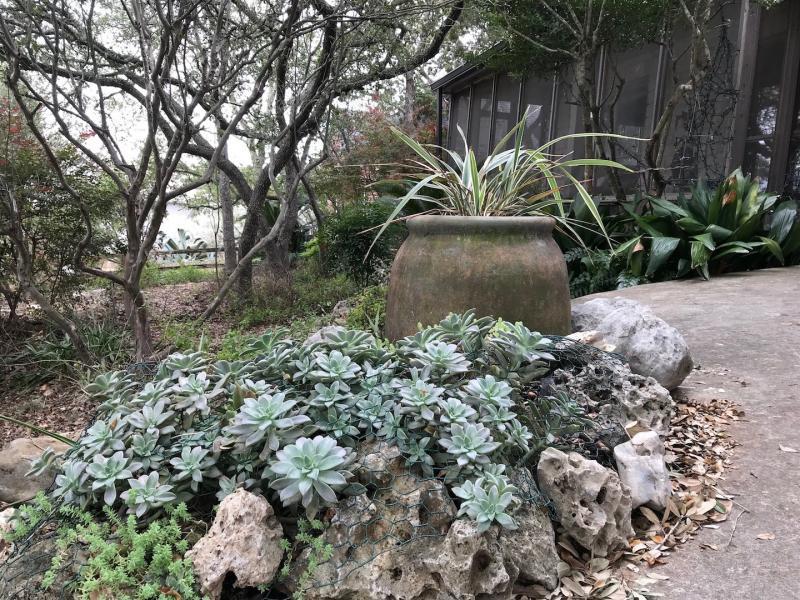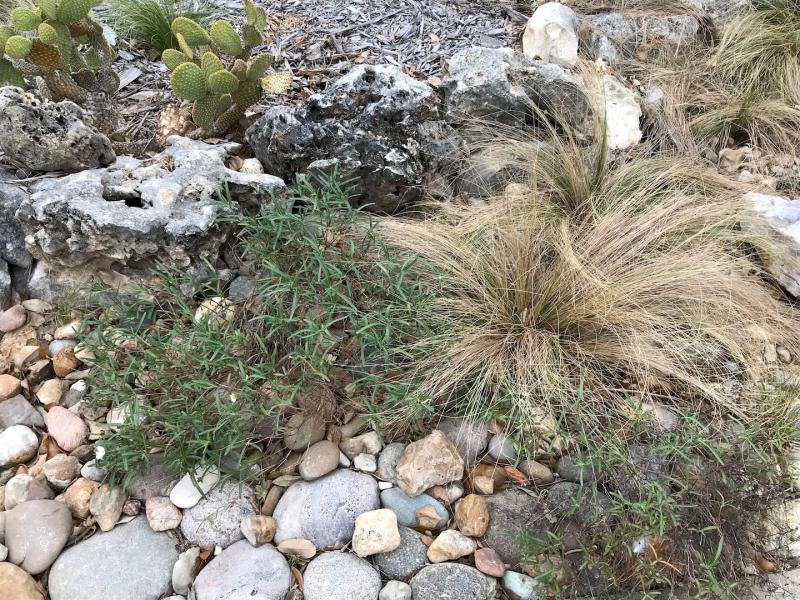
The Whitus' house on Spring Hollow Cove is the Spring Lake Garden Club's Yard of the Month. Their yard boasts of a large variety of native plants and shady groves of oaks, making it a cozy little urban retreat. Photos courtesy of the Spring Lake Garden Club
Creating an Urban Retreat
Spring Lake Garden Club’s yard of the month for January 2019 is a mix of native plants and adaptive species on an uphill lot with no lawn – exactly what Ann and Jerry Whitus were looking for when they moved to San Marcos about 10 years ago. Their home on Spring Hollow Cove in Castle Forest, is tucked away on a cul de sac in a subdivision but seems like an urban retreat, complete with a screened front porch from which they can view a variety of interesting plants instead of pavement and parked cars. Shaded by two motts (groves) of oak trees on each side of the yard, the landscape is welcoming yet private.

A screened front porch connects the landscape to the inside of the house and adds a peaceful viewing spot.
The home’s original owners had already used large boulders to terrace the lot sloping toward the street, but the Whituses added new plants, including succulents among the rocks, and also wanted to link the house and yard more closely, Their backyard feels like an extension of the indoor sitting area. Jerry Whitus explains that he’s always ready to help with heavy lifting, but that Ann Whitus is the main gardener. She earned certification as a Master Naturalist several years ago and now volunteers at the San Marcos Discovery Center (formerly the Nature Center) which is being revived by students from Texas State University along with Hays County Master Naturalists and Master Gardeners for the benefit of local residents.
Ann Whitus claims that maintenance on their yard is minimal and relies on using natural procedures such as breaking up plant trimmings and leaving them on the ground to become a natural mulch or a continuous compost layer. She has even buried tin cans in this layer so they can rust and help acidify the usual alkaline soil in our local area. Relying on native plants reduces the need for additional water or soil amendments, and welcoming volunteer plants adds to the variety of the front landscape. A young century plant recently appeared in the mix to join numerous yuccas (especially twist leaf) and red yucca (actually an aloe) in the natural landscape. A spiny cholla with cylindrical stems is thriving in a sunny space near the curb by the stone mailbox tower covered with grape ivy.

A vibrant bed of succulents and rocks are a natural mix in a sunny spot beside the driveway.
Besides the native live oaks, the Whitus’ front garden includes several small trees: the popular crape myrtle, Texas persimmon and a Mimosa borealis (thorny but attractive). Ann Whitus has filled out the front landscape with several large shrubs as well; pittosporum with its smooth waxy green leaves, cotoneaster showing bright red berries and Chinese fringe flower which features a mix of green and reddish leaves in fall and winter and red flowers in the spring.
Three thriving examples of so-called Texas sage or cenizo with distinctive graygreen leaves anchor the variety of front yard plantings. This species (Leucophyllum frutescens) blooms after almost every rain and is a drought-hardy native. Several true sages (Salvia officinalis) included in the Whitus’ landscape are also drought-tolerant and known as culinary or medicinal plants. Like these natives, the blackfoot daisies and feather grasses near the sunny curb area will thrive without additional water or special care. Asian jasmine is a reliable ground cover in other parts of the yard with partial shade.

Feather grass and blackfoot daisies thrive in a bed of rocks near the curbside mail tower.
Uphill in the yard’s shadier section, Ann Whitus has planted Sago palms and cast iron plants with their dark green leaves to screen the concrete foundation of the front porch. Contrasting with this deep green foliage are the striking red berries and fern-like green leaves of popular nandina, which must be controlled as an invasive but requires no care. The lower light levels of this shady area reduce the need for regular pruning, so vistas and individual plants can be appreciated from the rock pathways throughout the yard. And when pruning to control plant size or remove dead growth is necessary, Ann Whitus has already decided how to deal with the “waste” material: break it up, leave it in place and make more soil.











